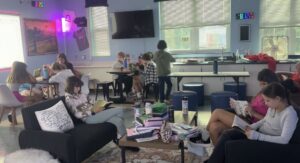
On a warm fall day in late October, the sounds of children on the playground fill the air in the quiet setting of the Croton-Harmon schools.
The 1,600 students at the three-building campus, set in A tree-filled neighborhood off the beaten path, go to school in a place that recalls long-ago, small-town America, where people know their neighbors and families plant roots that last for generations.
The Croton schools enjoy a legacy of strong academic achievement and wonderful teachers going back decades. The school system continues to draw parents looking for the best education for their children.
For District Superintendent Stephen Walker, his job is to build on this legacy and bring a new vision of public education to the community with a school board that understands the vision.
“Visualize a classroom from 1920 and visualize so many classrooms from 2020 — in a lot of places there will be very little change of the physical layout, including the delivery of instruction,” Walker said.
“Think about what other industry has not profoundly changed in the past 100 years. Private industry is based on boundary pushing, innovation, creativity and being on the cutting edge of things. We think education needs to be the same way.
“To do that you’ve to got to take some thoughtful risks and understand that some of it is not going to work, so you have to build a culture that is going to say we tried that, it didn’t work, let’s try the next thing.”

The Croton-Harmon Union Free School District is comprised of three buildings — Carrie E. Tompkins Elementary School, Pierre Van Cortlandt Middle School and Croton-Harmon High School — all within walking distance of each other. Students grow through their academic life in one place, gaining a sense of home at school. Reflecting the district’s close-knit scale, the high school’s Class of 125 numbers 130 students.
The district is in the midst of an expansive capital project that includes technology upgrades and extensive renovations of all three buildings to create new spaces, classrooms with moveable walls. Two of the buildings are 100 years old and are being modernized.
The capital improvements are all driven by the district’s vision of innovation in learning.
Part of that vision is having faculty members work together. At Carrie E. Tompkins Elementary School, classroom teachers and Special Area teachers join forces to create interdisciplinary lessons ranging from writing and performing short stories to incorporating music into a history lesson.
For example, fourth graders engaged in a two-part lesson on traditional Native American rain dances. Students first built their rain sticks and then acted out the different parts of a rain dance, creating the sounds of the storm with their custom creations. Through just this one project, students engaged in art, music, history, and science.
Middle school students engage in interdisciplinary courses combining Health with Physical Education, and Social Studies with English. At the high school, most incoming freshmen will experience an interdisciplinary Social Studies and English course called Connections: Maps, Stories and Timelines, as well as an algebra and physical science class called Quantitative Patterns in Physical Systems.
Making school a place where each student and teacher pursues their passion is another part of the vision.
A couple of years ago, Walker started a policy where faculty members devote time from their professional learning schedule, conference days and faculty meetings to do “anything that lights you up, inspires you, without accountability, with no reports — we don’t even need to know what you’re doing,” Walker says.
The next step was to bring the same principle of pursuit of passion to students.
“School should inspire you, should make you feel passionate about the world, and create young people who see themselves as learners and successful individuals,” Walker said.
For one student, pursuing his passion for badminton drew him out of his shell as he researched the history of the sport and created a marketing plan to teach other kids. “He wants to come to school now, and the other students want to speak with him,” his mother related.
Another group of girls decided their passion was eating cookies for breakfast. Realizing the downside, they researched healthy and gluten-free cookies and devised a way to monetize their passion.
With a grant from the Croton-Harmon Education Foundation, another set of students researched the cost of furnishings to create a comfortable seating area with lightning.
For Stephen Walker, being superintendent of schools in the Croton-Harmon district comes on a career path that began early. With his father a retired high school social studies teacher and former board of education member, and a mother who is a teaching assistant, school was instilled in him as a place of opportunity and a chance for young people to see the many options available to them and strive toward a fulfilling future.
“This is the best job I’ve ever had because of how varied it is, because of how incredibly challenging it is and because I get a chance to come to work every day with tremendously talented people who have also become family,” he said.
His role is to remind teachers why they got into education in the first place. “We think of educators as dreamers, they’re visionaries, and unfortunately sometimes school systems tamp that down year over year with repetition
“In business and in education, too many rules are based on people who struggle within the system rather than saying ‘we have amazing people, let’s make it the best for them and you lift others.'”
Peekskill resident Jim Roberts is a veteran journalist.






